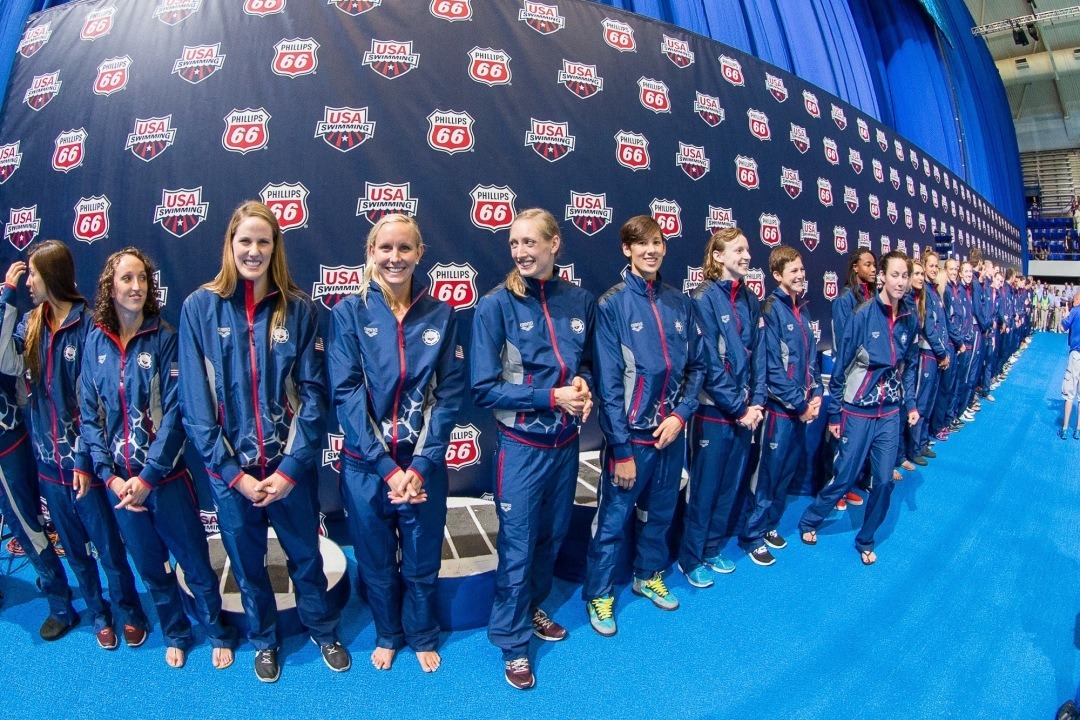Mitch Bowmile and Anne Lepesant contributed to this report.
During Thursday’s live webcast of the announcement for the qualifying standards for the 2016 U.S. Olympic Swimming Trials, the Assistant Executive Director of USA Swimming Mike Unger discussed how the standards are developed.
Referring to the process as an “inexact science,” Unger says that they look at what swimmers did last year, how many swimmers they want in each event, the age of the potential qualifiers and how that might affect the numbers over the next two years, etc.
In recognition of that inexact science, we went through post-facto and applied the new 2016 Olympic Trials standards to the 2012 Olympic Trials qualifying period. In other words, we went back-in-time and kept everything the same for 2012 trials qualification, with the exception of one variable: the standard.
As you can see, just as different events had wildly different numbers of eligible swimmers in 2012, the same could be true in 2016. But what this data really reveals is perhaps a bit of a peak inside where USA Swimming thinks the sport is heading in the U.S.
Some observations:
- The 2:01.99 time standard for the men’s 200 fly would’ve cut 100 eligible swimmers out of the mix for 2012. However, there’s already the exact same number of people (66) who hit that standard in the 2014 long course season. While those 66 won’t all count for 2016 qualifying, that’s a sign to USA Swimming that they’re justified in reducing that standard.
- In 2012, there was some effort made with the standard to keep the number of qualifiers in the distance events down. It’s not clear that the new standards will achieve that same goal – they don’t cut the numbers nearly as low as, say, the 200 free or 200 fly do.
- Both 100 freestyle cuts plummeted. USA Swimming has hesitated to play the “make the standards harder so swimmers step up their times” game like most of the world seems to be doing, but maybe this is a sign. Based on what we had heading into 2012 trials, only 67 men and 62 women would have made the cuts. If there’s one area where Americans really need to step up, it’s in the sprint freestyles. While these cuts aren’t going to scare the Nathan Adrians and Simone Manuels of the world, they do send a message that it’s going to take some really solid times to be in the field in the 100 freestyle in Omaha.

“The 2:01.99 time standard for the men’s 200 fly would’ve cut 100 eligible swimmers out of the mix for 2012. However, there’s already the exact same number of people (66) who hit that standard in the 2014 long course season. While those 66 won’t count for 2016 qualifying, that’s a sign to USA Swimming that they’re justified in reducing that standard.”
I’m a little confused by this statement. Does that mean that cuts made this past summer don’t count?
Question – it really should say “they won’t ALL count”. Times done at Junior Nationals and Nationals would, as would any other after July 30th.
Another very interesting thing that me and many people would love to see is the comparison/percentage difference of the top 8 from London to the new 2016 Olympic trials cuts. Here are the results for the men:
50free – 21.88 93.9%
100free – 48.38 95.4%
200free – 1:46.80 95.5%
400free – 3:47.25 95.2%
1500free – 14:57.59 94.5%
100back – 53.74 94.0%
200back – 1:57.33 94.8%
100breast – 59.78 93.9%
200breast – 2:09.31 93.4%
100fly – 51.85 94.6%
200fly – 1:55.13 94.4%
200IM – 1:58.49 94.7%
400IM – 4:13.33 94.7%
So based on these calculations, hypothetically around the top 5% of the trials qualifiers will have a chance to make the medal final.… Read more »
This is interesting particularly because the men’s 100/200 breast cuts saw substantial (the biggest?) drops in time.
The depth of breaststroke performances over the past four years has improved tremendously.
Alright probably not, but why are the women’s cuts clearly slower than the men’s? Fina power points with American Women being internationally faster comparatively in the stroke events or what?
The women’s cuts are clearly slower than the men’s cuts because statistically in swimming, women swim slower than men.
Interesting analysis and obviously it’s interesting to look at the progression of Trial cuts over time. I think its also interesting to compare 2014 Summer cuts to 2016 Trial cuts. I suspect that is a more recent “snapshot” of where one could expect the numbers to look like in two years.
BTW, the Trials 100 free cut is only .20 faster for the men and SLOWER than the national cut for women. How does that act as a “stretch goal” for our 2016 sprinters?